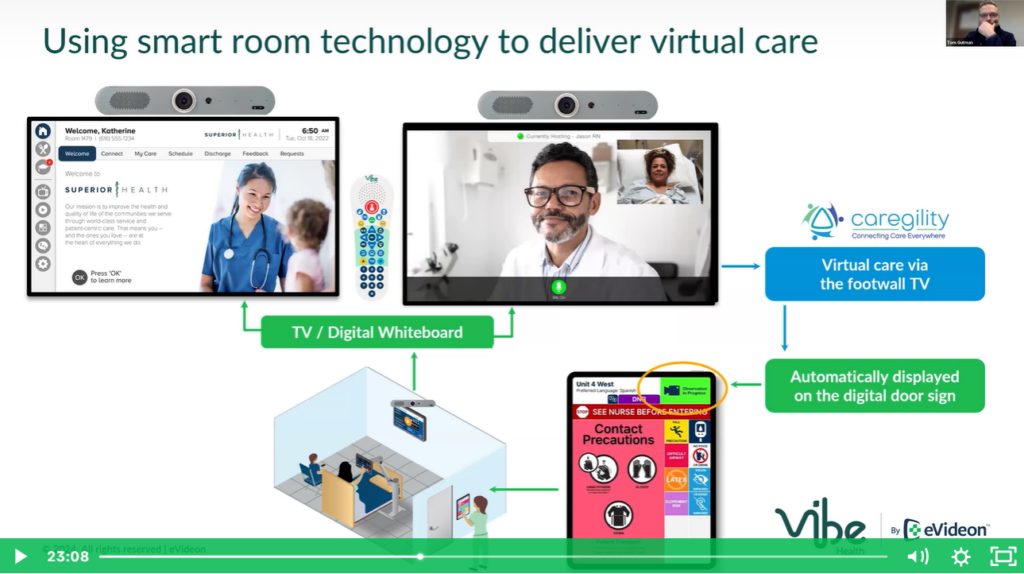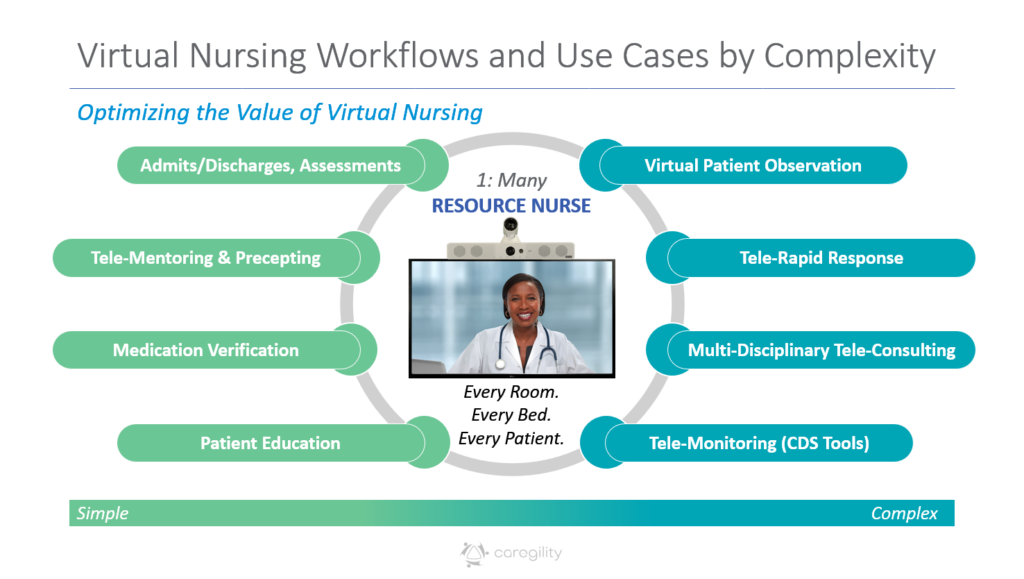Staffing shortages, clinician burnout, and overwhelmed new hires – sound familiar? The same challenges hindering hospitals across the nation prompted the team at OhioHealth to create Virtual Nursing “smart rooms” to help stem the tides of nurse attrition. Executives from the health system and their technology partners recently shared their experience getting the emerging care model off the ground in the webinar “Clinical Workflow Optimization: The Role of Virtual Nursing.”
Arika Thomas, MBA, BSN, RN, Director of Nursing for Inpatient Services at OhioHealth’s new Pickerington Methodist Hospital; Erica Braun, MFA, User Experience and Product Design Advisor for OhioHealth; and Tom Gutman, MBA, Senior Consultant of Simulation Technology for OhioHealth, joined eVideon Clinical Implementation Director Erin Pangallo, MS, BSN, RN, and Caregility Clinical Program Manager Ben Cassidy, MBA, MSN, RN, CCRN, to discuss the health system’s approach.

Using Smart Room Technology to Deliver Virtual Care
OhioHealth’s Pickerington Methodist Hospital, which opened on December 6, 2023, was built with Virtual Nursing and digital patient engagement in mind. Patient rooms at the hospital are outfitted with a 65-inch smart TV connected to Caregility’s new APS100 Pro telehealth edge device.
Each “smart room” is powered by the Vibe Health by eVideon smart room platform, which includes the Insight digital whiteboard, Aware digital door sign, Companion bedside tablet, and interactive Engage TV solution. These solutions elevate the inpatient experience with personalized communication, tailored education, and self-service tools that improve patient satisfaction, loyalty, and outcomes while alleviating non-clinical responsibilities for bedside nurses.
Integration with the Caregility Cloud™ virtual care platform allows the OhioHealth team to seamlessly facilitate bedside Virtual Nursing and Virtual Patient Observation sessions via the footwall TV. Together, the platforms create a digital health hub in every patient room that allows hybrid care teams (virtual and in-person) to work together seamlessly to provide patients with the highest level of care and meaningful interaction throughout their care journey.
A Co-Caring Approach to Nursing
OhioHealth’s Virtual Nursing journey was methodical and collaborative, beginning with a co-design phase that involved an in-depth review of internal workflows alongside floor nurses. This phase aimed to identify and eliminate “pebbles in the shoe” of RNs, as Thomas puts it – small, yet significant inefficiencies in workflows and routines. Following a nine-month pilot at two sister site units, the program was refined and launched at Pickerington, with the hospital now reaping the benefits of this innovative approach to nursing.
The co-caring model, a cornerstone of OhioHealth’s program, blends traditional and virtual nursing roles to create a hybrid care team. This model includes bedside RNs and LPNs handling direct patient care, patient support assistants (PSAs) managing daily living activities, and virtual nurses focusing on administrative tasks, patient education, and care coordination. Virtual nurses support 15 to 20 patients assigned to their nursing team.
Just two months into the program, OhioHealth’s collaborative approach has led to significant improvements in patient and nurse satisfaction, with nurses reporting reduced stress and more time for bedside care. Patients appreciate the added care provided by virtual nurses.
“We’re also looking at usability and frequency metrics,” said Braun. “Caregility has a great backend dashboard we’re monitoring to see how many calls our virtual nurses are taking in a day, on certain days, and at certain times of day. Right now, we have two virtual nurses per shift. We’re trying to assess, as we grow at Pickerington and beyond, is this enough? Are they covering too many or too few patients? We’re really trying to understand their productivity to inform how we could scale.”
How to Start and Scale Virtual Nursing
During the discussion, speakers offered advice to other health systems looking to get started with or scale Virtual Nursing.
“Our recommendation is to start with a big win that’s easy to implement,” said Cassidy. “Once you have that one device set up in one patient’s room and one virtual nurse, you can carry out simple workflows. Think about admissions and discharges as well as hourly rounding and assessments. Those are where you’ll see the biggest time savings. You may also see some reduction in incremental overtime by taking some of that heavy documentation off the bedside.”

“Then you can move over to more complex workflows,” Cassidy continued. “You can have multiple use cases using the same device in that patient’s room at the same time. You can have a wound care nurse go in to do their assessment and on top of that, you can have someone virtually observing the patient in a sitter format. Expanding that model is a big lift but it’s also needed. Making that “room of the future” allows you to impact care throughout the entire organization, not just one unit or facility.”
Elevating the Standard of Care
The success of Pickerington Methodist Hospital’s Virtual Nursing program is a testament to the power of innovation and collaboration in healthcare. The hospital has set a new standard for nursing care that better addresses staffing shortages, enhances nurse and patient satisfaction, and improves overall care quality. As the program scales, its impact is expected to grow, offering a blueprint for other institutions seeking to embrace virtual nursing “smart room” technology.
OhioHealth’s journey from conceptualization to successful implementation highlights the transformative potential of technology in healthcare. By prioritizing co-design, embracing technological solutions, and fostering a collaborative care model, the health system has not only enhanced care delivery but also positioned itself as a leader in healthcare innovation.
Do you have questions about Virtual Nursing? Set up a discovery call with one of our specialists today!







